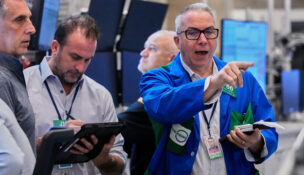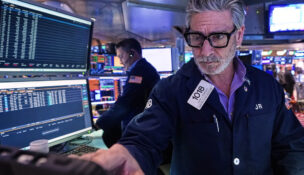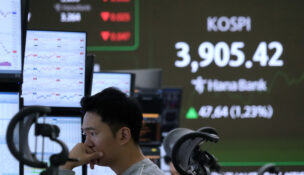Select Region or Brand
- Industries
- Regions
- Events
- Opinion
- Awards
- Leads & Data Center
- Issues
- December 2025
- 26th Annual Legal Elite
- November 2025
- Virginia Meetings 2025
- October 2025
- Hampton Roads Business 25
- Virginia 500 2025-26
- September 2025
- August 2025
- Site Locator 2025
- July 2025
- June 2025
- Start Virginia 2025
- May 2025
- April 2025
- March 2025
- February 2025
- January 2025
- Top Doctors 2025
- 25th Legal Elite 2024
- December 2024
- Virginia 500
- Press Releases
- Advertising
Stock market today: Wall Street rises in another jittery day ahead of Trump’s tariff announcement

New York Stock Exchange facade on Wall Street. PHOTO: ADOBESTOCK
Stock market today: Wall Street rises in another jittery day ahead of Trump’s tariff announcement

New York Stock Exchange facade on Wall Street. PHOTO: ADOBESTOCK
Stock market today: Wall Street rises in another jittery day ahead of Trump’s tariff announcement
NEW YORK (AP) — U.S. stocks whipped through another dizzying day Wednesday in the final hours before President Donald Trump’s unveiling of the tariffs promised as part of his “ Liberation Day,” which could drastically remake the global economy.
The S&P 500 rose 0.7%, but only after careening between an earlier loss of 1.1% and a later gain of 1.1%. It’s had a pattern this week of opening with sharp drops only to finish the day higher.
The Dow Jones Industrial Average added 235 points, or 0.6%, and the Nasdaq composite climbed 0.9%. Both also veered from sharply lower in the morning to sharply higher in the afternoon before doubling back.
Elon Musk’s Tesla helped knock the market around after initially falling more than 6% following a report that it delivered fewer electric vehicles in the first three months of the year than it did in last year’s first quarter.
Tesla is one of Wall Street’s most influential stocks because of its immense size, and it’s faced backlash due to anger about CEO Elon Musk’s leading the U.S. government’s efforts to cut spending. But its stock erased its loss from the morning and ended with a gain of 5.3% following a report from Politico that Trump has told others that Musk will step back from his government role in coming weeks.
Financial markets around the world have broadly been shaky lately because of uncertainty about Trump’s trade war. He has said he wants tariffs to make the global system more fair and to bring manufacturing jobs back to the United States from other countries. But tariffs also threaten to grind down growth for the U.S. and other economies, while worsening inflation when it may be stuck above the Federal Reserve’s 2% target.
One of the hopes that’s helped push upward on the U.S. stock market recently is the possibility that at least the worst of the uncertainty around tariffs may be passing.
“We do not know how long the previously enacted tariffs and any future tariffs will remain in force, but we believe peak tariff uncertainty may soon be behind us,” according to Kurt Reiman, head of fixed income Americas, and other strategists at UBS Global Wealth Management. “Much of the work the administration set out to achieve will have been put in place, and there are numerous potential offramps available.”
After the market closed, Trump declared a 10% baseline tax on imports from all countries and higher tariff rates on dozens of nations that run trade surpluses with the United States. The president held up a chart while speaking at the White House, showing the United States would charge a 34% tax on imports from China, a 20% tax on imports from the European Union, 25% on South Korea, 24% on Japan and 32% on Taiwan.
Among the companies whose shares fell in after-hours trading were Deckers Outdoor, the maker of Uggs, down 9.3%; Lululemon was down 8.8%; and home products retailer Williams-Sonoma was down 8.4%.
Before Liberation Day, Trump had already announced 25% tariffs on auto imports; levies against China, Canada and Mexico; and expanded tariffs on steel and aluminum. Trump has also put tariffs against countries that import oil from Venezuela and plans separate import taxes on pharmaceutical drugs, lumber, copper and computer chips.
But even if Trump’s tariffs ultimately end up being less harsh than feared, a worry hitting the market is that their herky-jerky rollout may by itself create enough nervousness to get U.S. households and businesses to freeze their spending, which would damage the economy.
Surveys have shown deepening pessimism, but economists are waiting to see if that translates into actual damage for the economy. A report on Wednesday suggested the U.S. job market may still be running stronger than expected.
The report from ADP Research said employers, excluding the government, accelerated their hiring last month by more than economists estimated. It could be an encouraging signal for the more comprehensive jobs report coming Friday from the U.S. government. Economists expect that to show overall hiring slowed in March from February.
The job market has been one of the linchpins keeping the U.S. economy out of a recession.
Treasury yields swung in the bond market, echoing the indecision seen in the stock market.
The yield on the 10-year Treasury fell as low as 4.11% in the morning from 4.17% late Tuesday and from roughly 4.80% early this year. But it later rose to 4.18%. Higher yields can indicate higher expectations for the economy or for inflation.
On Wall Street, Newsmax fell 77.5% in its third day of trading to give back some of the meteoric gains from its debut at the start of the week. It surged 735% Monday and then another 179% on Tuesday.
Several airlines, meanwhile, flew higher to recover some of the sharp losses taken recently on worries that tariff-weary customers will fly less. United Airlines climbed 4.6%.
All told, the S&P 500 rose 37.90 points to 5,670.97. The Dow Jones Industrial Average added 235.36 to 42,225.32, and the Nasdaq composite climbed 151.16 to 17,601.05.
In stock markets abroad, indexes were mixed across Europe after finishing mixed in Asia.
___
AP Business Writers Yuri Kageyama and Matt Ott contributed.

















